| Already a member? Login Now! |
|
 |
|
3 great ways to use Student News Net!
SNN invites you to sign up for a subscription for our award winning site, with access to great stories and educational features. Obviously we are proud of our accomplishments, but we really want to share the truly engaging stories and custom features for the classroom and beyond.
As an ad-free site, SNN relies on subscriptions to enable it to produce this award winning educational website. Where else can you get daily updates of engaging stories and current events backed up by interdisciplinary activities and extra features?
|
|
|
|
|
 |
 Slog: verb – to work diligently for long hours slogged, slogging, slogs Slog: verb – to work diligently for long hours slogged, slogging, slogs
(The American Heritage Dictionary of the English Language, Fifth Edition, ©2014 by Houghton Mifflin Harcourt Publishing Company) |
 |
|
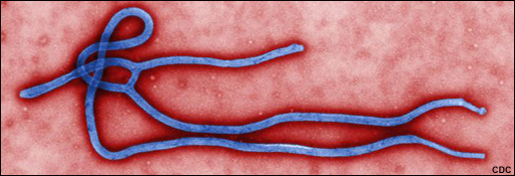 |
|
|
| Join SNN Friday, October 24 at 3:20 p.m. EDT for a live SLOG chat about the Ebola virus. Dr. Eden Wells, Clinical Associate Professor of Epidemiology and Director, Preventive Medicine Residency in the School of Public Health at the University of Michigan, will be sharing her extensive knowledge of communicable diseases and Ebola to answer the many questions students and teachers have about the virus. Meet Dr. Wells through this video introduction. Join the chat on Friday! |
| EXTRA! EXTRA! WRITING PRACTICE |
| |
| Practice Your Writing Skills by summarizing what you've learned by reading, sharing and participating in this SLOG. |
 |
|
|
| SNN SLOG - Ebola Virus |
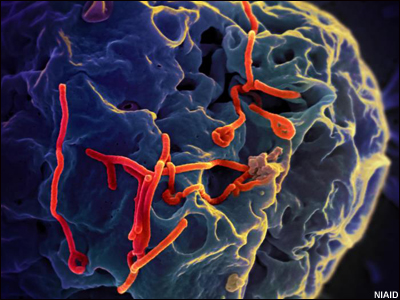
A number of filamentous Ebola viruses (in red) have budded from a monkey kidney cell. (Photo: NIAID/CDC). |
The Hot Zone – follow up to Oct. 24 live SLOG-ITT session about Ebola
Oct. 27, 2014 - The Hot Zone, a 1994 New York Times best selling nonfiction book by Richard Preston about the first appearance of the Ebola virus in the United States, is red hot right now. It's again a New York Times best selling book; it's an Amazon's top 100; and is flying off library shelves. During Friday's live SLOG-ITT session with Dr. Eden Wells, MD, MPH, an Iowa teacher asked her a question about the book's discussion of airborne transmission of Ebola. It was a great question. Learn why Ebola is NOT spread by air but only by direct contact with bodily fluids infected with the Ebola virus.
|
|
| |
Two nurses infected with Ebola virus
Oct. 16, 2014 – The Ebola virus was first recognized in 1976 in Africa, one of several viruses responsible for viral hemorrhagic fever. Since that time, Ebola has caused sporadic outbreaks in Africa with hundreds of cases. But in March 2014, a severe outbreak began in West Africa with cases now in the thousands. Over 4,000 people have died there. Ebola is highly virulent with mortality rates 50 percent or higher. On Sept. 20, a person exposed to Ebola in Liberia traveled to Dallas, Texas where he became ill four days after arriving. He was diagnosed with Ebola and died on Oct. 8 from the infection, the first case and Ebola death in the U.S. Two nurses who took care of him have now been diagnosed with Ebola. Ebola is only spread through direct contact with body fluids of infected patients. Patients without symptoms are not contagious. Symptoms include fever (> 101.5 F), severe headache, weakness, vomiting and unexplained hemorrhage. The disease is called Ebola hemorrhagic fever (Ebola HF). Ebola patients develop symptoms from 2-21 days (average is 8-10 days) after being infected. Antibiotics are not effective against Ebola or any virus. There is no vaccine for Ebola.
|
|
| Multimedia |
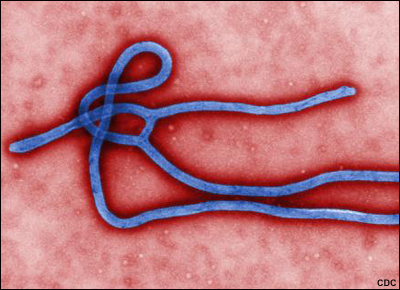 |
|
| This Ebola virus particle is a long helical virus. Viruses come in many shapes but all viruses are made up of a protein coat (capsid) and a piece of nucleic acid (either RNA or DNA). Viruses take over human cells and use cell components to make more viruses unlike bacteria that can divide on their own. (Photo: CDC/Cynthia Goldsmith). |
Video: CDC Disease Detectives: LT. Kelsey Mirkovic
In this August 2014 video (1:28), Lt. Kelsey Mirkovic speaks about her recent assignment in West Africa in the area where the Ebola outbreak is thought to have originated. She was in West Africa to help stop the outbreak there. |
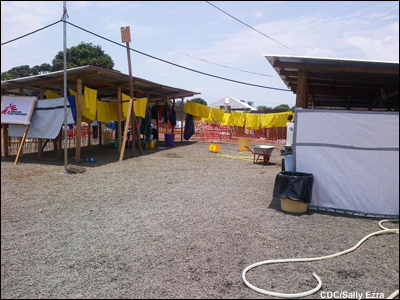 |
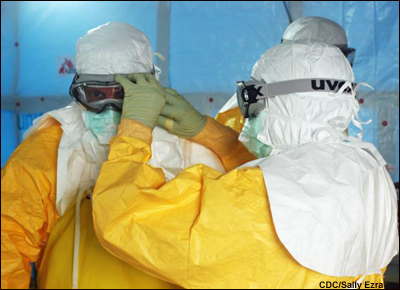 |
This photo was taken at an outdoor Ebola clinic in Monrovia, Liberia's capital city, during the 2014 Ebola HF outbreak. The clinic opened on August 17, 2014 and is operated by Doctors Without Borders. (Photo: CDC/Sally Ezra). |
Dr. Jordan Tappero of the CDC is being assisted with his protective gear by a member of Doctors Without Borders in Monrovia, Liberia during the 2014 Ebola HF outbreak. (Photo: Sally Ezra/CDC) |
|
|
|
|
|